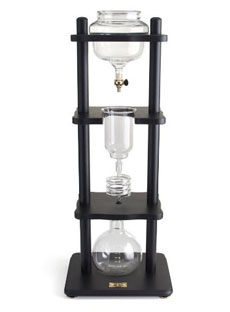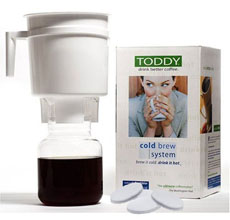The History Of Cold Brew Coffee & How To Make Cold Brew
|
If you’ve been anywhere near an upscale coffee shop lately—Caribou, Peet’s, Starbucks and many others, you know that the latest trend is cold-brew coffee.
Rather than brewing ground coffee the traditional way, cold-brew creates a coffee concentrate by steeping the coffee grounds in cold or room temperature water, for 12 hours and up to twice that if you like strong coffee. Starbucks steeps their cold-brew for 20 hours. For this reason, cold-brew is pricier than a regular brew. But it’s easy to steep at home. The benefits: For those who prefer convenience, bottles of cold-brew coffee concentrate ready to turn into hot or iced coffee, as well as individual ready-to-drink bottles of cold-brew, are sold at better stores from coast to coast. In the late 1960s, a garden nursery owner and chemist named Todd Simpson was on a plant-gathering trip to Guatemala, when he was served a delicious cup of coffee made from concentrate. Impressed, he developed the Toddy cold-brew coffee maker in his garage (source). But wait: While doing research, we discovered Kyoto-style Japanese coffee, a cold brew that originated in the 1600s. Thus, according to Daily Coffee News, cold brew coffee originated in Japan four centuries before Todd Simpson came across it in Guatemala. Coffee in Japan in the 1600s? It turns out that Dutch traders needed their coffee. Back in the 1600s, there was no electricity; coffee was brewed by dripping hot water through the grounds. Cold-dripped or hot-dripped coffee concentrate—“coffee essence”—would have been a means of transporting prepared coffee to be heated and consumed on-board. The traders brought the technique to Japan, where it became known as Dutch coffee. Japanese artisans created elegant, tall glass brewing towers that were popularized at shops in Kyoto, Japan, the earliest record of cold-brew coffee. Over the centuries, Kyoto-style brews have become highly artistic. Instead of submerging grounds for hours, the coffee is brewed drop by drop. A single bead of water is let down through the coffee grounds at a time, creating a process that takes just as much time as using a Toddy, and beautiful to watch. As the Japanese were cold-brewing tea at that time, the process was in place to cold-brew coffee (source). How extensively was the technique used beyond Japan? The record is not clear; but in days before electricity, when tending fires and boiling water was a lot of work, cold-brewing may have been a method used in coffee-drinking elsewhere. |
 [1] The Takeya Cold Brew Iced Coffee Maker (photos #1 and #2 © Takeya USA).
|
|
 [4] This three-tiered Kyoto-style cold-drip brewer is more than two feet tall (photo © Yama Glass). There are versions that are even larger and more elaborate.
|
MORE COLD-BREW HISTORY According to an extensive article in The Guardian, there are indications that cold-brew coffee might have first been made in Peru, Guatemala or Java. But the documentation is sparse. Some of the earliest documented coffee concentrates originated as military rations. The Americans, the French and the Brits all simmered down a coffee concentrate for soldiers to reconstitute in the field. The breakthrough, according to The Guardian, happened in Japan in the late 1960s. At that time, canned flavored milk, including coffee-flavored milk, was popular in Japan at that time. Businessman Ueshima Tadao thought to flip the ingredient ratio into a can of coffee with just a small amount of milk and sugar. He subsequently created a black coffee version. Thus, the final chapter of cold-coffee history was made by Ueshima Coffee Co., Ltd.; although it took a decade for UCC Coffee With Milk to really catch on. Shortly thereafter, in the 1970s, Italian coffee giant Illy introduced ready-to-drink black coffee in a can. The concept continued to expand until…well…check out the bottled coffees and concentrates on the shelves of the nearest market. |
|
|
|
||



